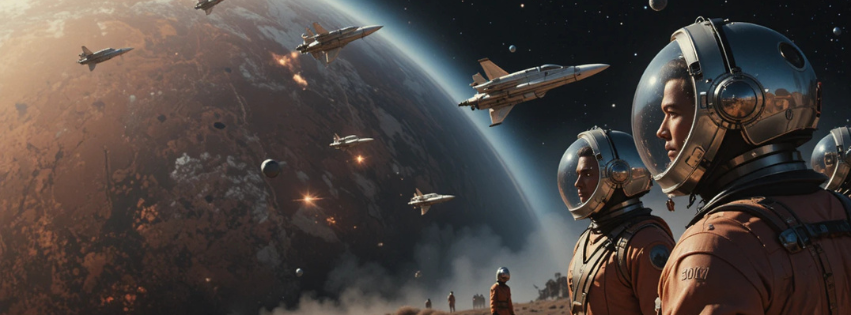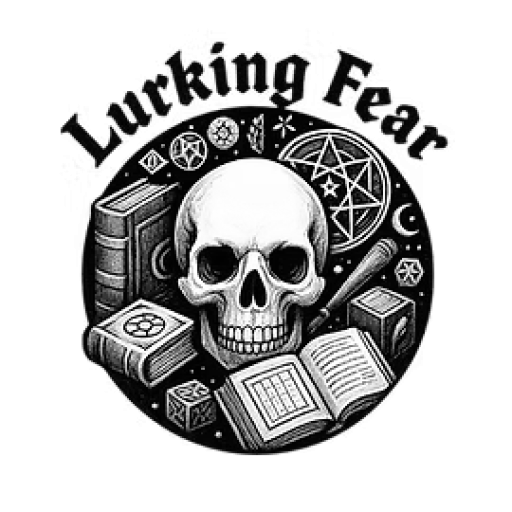How the Golden Age and New Wave Titans Forged Modern Sci-Fi
By Joey Stardust, Lurking Fear Publishing
www.lurkingfear.com

Pull up a chair, space cadets and cyber-surfers. Grab a synth-ale or a steaming mug of recaf. We’re going on an excavation. Not into the radioactive ruins of some forgotten Earth, but into the foundational strata of the genre we all love. I’m talking about the classics—the dog-eared paperbacks with lurid covers, the pulpy tales that first dared to ask “What if?” and in doing so, built the very language we use to talk about the future.
It’s a common, almost lazy, criticism to dismiss the sci-fi of yesteryear as quaint, clunky, or overly optimistic. We see the rocket ships that look like art-deco bullets and the computers that fill entire rooms and we chuckle. But to do that is to miss the point entirely. The giants of the Golden Age and the rebels of the New Wave weren’t just predicting gadgetry; they were performing an autopsy on the human condition, using the future as their scalpel. They are the ghosts in the machine of every modern sci-fi author’s imagination, and their DNA is woven into the very fabric of the stories we consume today.
So, let’s fire up the time machine and trace the lineage. Let’s see how the foundational pillars laid down by the old masters are holding up the glittering, neon-drenched, and often terrifying skyscrapers of modern science fiction.
Pillar I: The Sociological Scalpel of Isaac Asimov & Arthur C. Clarke
First, let’s talk about the architects. Isaac Asimov and Arthur C. Clarke didn’t just tell stories; they built intellectual frameworks. They were less concerned with laser gunfights and more with the grand, sweeping systems that would govern humanity’s future.
Asimov’s Foundation didn’t give us flashy tech; it gave us psychohistory—the mathematical sociology of vast populations. Sound familiar? It should. This is the bedrock of Neal Stephenson’s Snow Crash and The Diamond Age, where information theory and memetics are the new forces of history. It’s the conceptual grandfather of the data-driven empires in Ann Leckie’s Ancillary Justice, where an AI doesn’t just control ships, but perceives and manipulates vast social structures. Asimov taught us that the most powerful force in the galaxy isn’t a plasma cannon, but a trend line. Modern authors have simply updated the tools from statistical math to big data algorithms and neural networks.
Then there’s Arthur C. Clarke, the poet of the transcendent. His law—”Any sufficiently advanced technology is indistinguishable from magic”—is more than a pithy quote; it’s a narrative cheat code. Clarke understood that awe and mystery were more powerful than technical schematics. This sense of cosmic wonder, of humanity being a small, fragile thing in the face of the sublime, is the direct ancestor of the “Big Dumb Objects” and alien enigmas that define so much modern sci-fi.
Think of the Ringworld in Larry Niven’s work, the Shellworlds of Alastair Reynolds’ Revelation Space universe, or the mysterious alien artifacts in films like Arrival (based on Ted Chiang’s sublime story, itself a child of this tradition). These are all Clarke’s children. He taught authors that the universe doesn’t have to be hostile to be terrifying; it can simply be indifferent, and its secrets can unravel us just as easily as its weapons.
Pillar II: The Cynical, Gritty Mirror of Philip K. Dick
If Asimov and Clarke were building grand, pristine models, Philip K. Dick was smashing them with a sledgehammer and then questioning whether the sledgehammer was even real. Dick’s influence is the most pervasive and arguably the most vital in modern sci-fi. He looked at the post-war American dream and saw a fragile, paranoid nightmare lurking beneath the laminate.
His core obsession—“What is real?”—is the central nervous system of the entire cyberpunk movement and its descendants. In Do Androids Dream of Electric Sheep?, the line between human and android, between authentic emotion and chemically-induced empathy, is blurred into irrelevance. This is the foundational text for William Gibson’s Neuromancer, where identity is a data construct that can be backed up, stolen, or erased. It’s the anxiety that powers the ghost-dubbing and cortical stacks of Richard K. Morgan’s Altered Carbon. Dick’s paranoid vision of reality as a manipulable, untrustworthy interface is now our daily life, a fact modern authors explore with chilling precision.
Dick also gave us the dystopian, corporate-controlled future not as a grand spectacle, but as a banal, crushing reality. The mood organs and empathy boxes of his worlds are the direct ancestors of the targeted ads and social credit scores of modern dystopias like those in Black Mirror. He showed us that the future wouldn’t just be oppressive; it would be cheap, tacky, and psychologically draining. This cynical, street-level view is the antithesis of the gleaming Federation starship, and it’s the lens through which much of the 21st century’s most relevant sci-fi is viewed.
Pillar III: The New Wave & The Literary Revolution (Le Guin, Ballard, et al.)
In the 1960s and 70s, a group of writers got tired of rockets and robots. The New Wave crashed onto the shore, bringing with it a focus on inner space—psychology, sociology, sexuality, and language. They declared that the most alien landscape was the human mind.
Ursula K. Le Guin is perhaps the most profound of these influences. In The Left Hand of Darkness, she didn’t just create an alien world; she created an alien gender, using the Gethenians to dissect our most fundamental assumptions about sex, love, and power. This is the birth of the anthropological approach to sci-fi. You can see its DNA in the intricate, culture-clash narratives of China Miéville’s Embassytown, where language itself is the alien artifact, and in the carefully constructed societies of N.K. Jemisin’s The Broken Earth trilogy, where oppression and power are explored through a geological and sociological lens. Le Guin taught sci-fi that it could be a tool for radical empathy and a laboratory for social structures.
Then there was J.G. Ballard, the poet of entropy. While others looked to the stars, Ballard looked at the abandoned shopping mall and the decaying concrete overpass. He found the future in the ruins of the present. His “catastrophic” works, like The Drowned World or Crash, are less about the disaster itself and more about the new, perverse psychologies that bloom in its wake. This internalization of apocalypse is everywhere today. The melancholic, character-driven post-apocalypses of Emily St. John Mandel’s Station Eleven or the psychological unraveling in Jeff VanderMeer’s Annihilation are deeply Ballardian. They understand that the end of the world is not an event, but a feeling.
Case Studies: The Lineage in Action
Let’s get specific. You can’t understand the modern greats without seeing the classic threads they’ve woven into their tapestries.
- William Gibson: Gibson is often called the father of cyberpunk, but he’s really the synthesizer. He took Dick’s paranoia and crumbling reality, Ballard’s fascination with the pathology of the modern landscape, and Alfred Bester’s frenetic, media-saturated style (from The Stars My Destination), and fused them with the emerging tech of the 80s. Neuromancer is a direct dialogue with its predecessors, but it translated their anxieties into the new lexicon of cyberspace.
- Iain M. Banks: Banks’s Culture series is a masterful fusion of the grand and the personal. The vast, utopian-scale canvas of a post-scarcity society is pure Golden Age optimism, a direct conversation with Clarke. Yet, the stories are often gritty, personal, and morally ambiguous, filtered through the lens of the New Wave’s psychological focus and cynicism. He took the two seemingly opposed pillars and built a bridge between them.
- N.K. Jemisin: Jemisin’s work is a perfect example of how modern authors aren’t just influenced by the classics, but actively critique and expand upon them. The Fifth Season uses the tools of world-building and sociological speculation pioneered by Le Guin and Herbert, but centers them on themes of systemic racism, oppression, and motherhood that were often marginalized in the older works. She is not just inheriting the tradition; she is revolutionizing it from within.
- Andy Weir: The Martian and Project Hail Mary are love letters to the problem-solving, hard sci-fi of Arthur C. Clarke. They are almost pure exercises in “the science is the hero,” stripping away the New Wave interiority and the cyberpunk cynicism to return to a core Golden Age principle: human ingenuity, logic, and science against a hostile cosmos. It’s a testament to the enduring power of that foundational pillar.
The Evolution, Not the Eradication
So, has modern sci-fi outgrown its ancestors? Absolutely not. It has evolved, matured, and diversified. The classic influences aren’t rigid blueprints to be copied; they are a toolkit, a vocabulary.
- The Optimism/Pessimism Dial: The unbridled optimism of the Golden Age has been tempered by the cynical realism of Dick and the New Wave. Modern sci-fi is rarely purely one or the other; it exists in the tense, fascinating space between. We see utopias with dark undersides (The Culture) and dystopias where glimmers of humanity persist (The Road, Station Eleven).
- The Focus on Character: The New Wave’s insistence on interiority won. The “idea as hero” model of the Golden Age is now almost always fused with deep, complex character studies. We care about the physics of a black hole because we care about the people orbiting it, as in Interstellar.
- Thematic Expansion: The classics, for all their brilliance, were often limited in their perspective, dominated by a particular demographic. Modern sci-fi, building on the paths they paved, has exploded into a kaleidoscope of voices, exploring gender, race, colonialism, and sexuality with a depth and nuance that was previously rare.
The ghosts of Asimov, Clarke, Dick, Le Guin, and all the rest are not silent. They whisper in the circuitry of every AI, they haunt the corridors of every generation ship, and they stare back at us from the event horizon of every black hole. They gave us the maps, and while modern authors are charting new and wilder territories, they are still, in many ways, using those original maps as a guide.
So next time you crack open a brand-new, cutting-edge sci-fi novel, take a moment. Look past the bio-augmentation and the quantum drives. Listen closely. You’ll hear the echoes of psychohistory, the static of a fractured reality, and the quiet, profound questions about what it means to be human in a universe of wonders and terrors. The future, it turns out, is still under construction, and its best architects are the ones who learned from the masters.
Keep looking up, and keep looking within.
Joey Stardust
Lurking Fear Publishing

